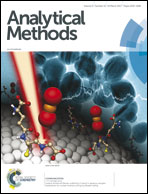Synthesis and evaluation of ion-imprinted sol–gel material of selenite†
Abstract
Highly selective selenite (SeO32−) ion-imprinted polymers (Se(IV)-IIPs) were prepared by the combination of surface ion-imprinting and sol–gel techniques and were then successfully used for the selective removal and preconcentration of Se(IV) in an aqueous solution. Using a modified Stöber method, SiO2 nanoparticles (SiO2 NPs) were prepared, which reacted with 3-(2-aminoethylamino) propyltrimethoxysilane (dAPTES) in an acidic medium in the presence of Se(IV) (template ion). Thin surface-imprinted layers of selenite were formed on SiO2 NPs. Using a 2 M HCl solution as the eluting solvent, Se(IV) can be thoroughly removed from the nanomaterials. Synthesis conditions as well as the factors affecting the adsorption and desorption processes of selenite, such as initial sample concentration, pH, and the types of eluting solvents, were investigated in detail. The capacity and selectivity of the prepared materials for Se(IV) were also investigated, and the experimental data indicated that the new materials have the maximum adsorption capacity of 469.48 μg g−1 and are highly selective to Se(IV). The adsorption process fitted well with the pseudo-second order model with the correlation coefficient r2 = 0.991. The applicability of the nanomaterials was also demonstrated by the selective adsorption of Se(IV) in real environmental water samples.



 Please wait while we load your content...
Please wait while we load your content...